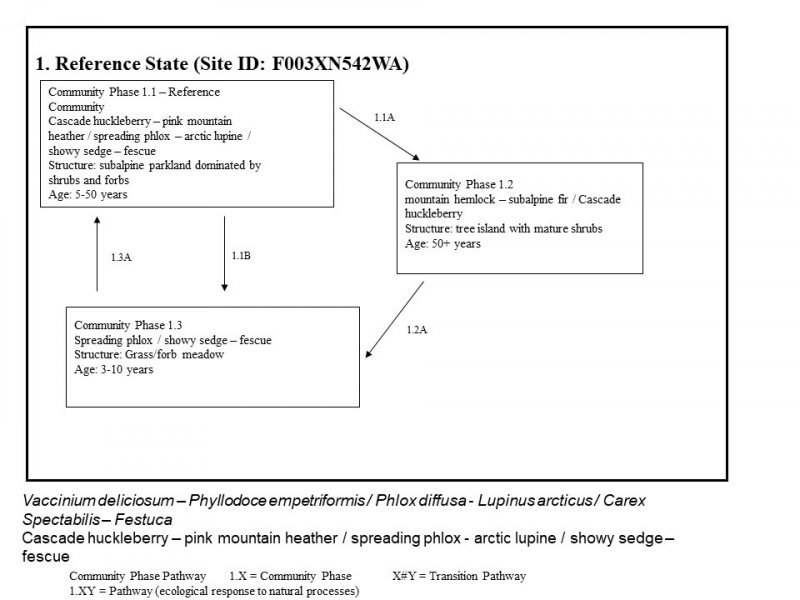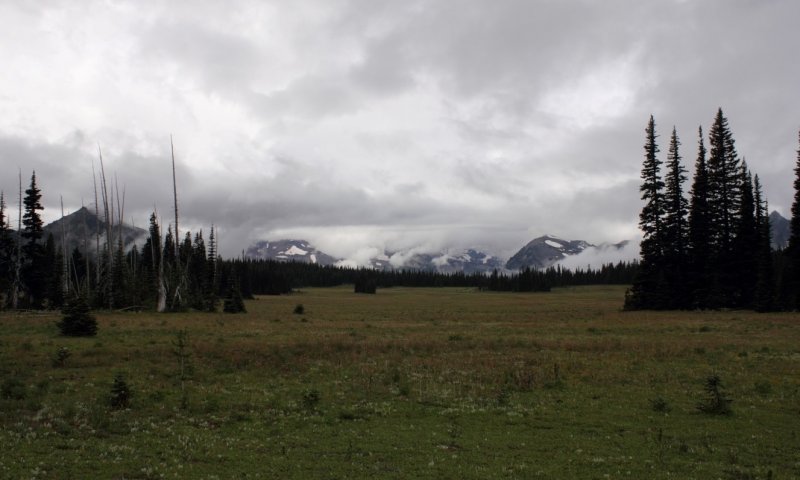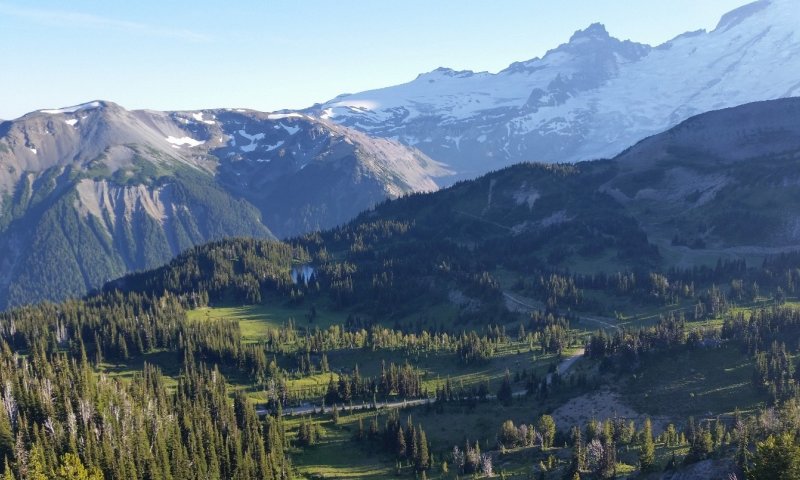

Natural Resources
Conservation Service
Ecological site R003XN542WA
Southern Washington Cascades Subalpine Parkland
Last updated: 1/29/2025
Accessed: 12/19/2025
General information
Provisional. A provisional ecological site description has undergone quality control and quality assurance review. It contains a working state and transition model and enough information to identify the ecological site.
MLRA notes
Major Land Resource Area (MLRA): 003X–Olympic and Cascade Mountains
Steep mountains and narrow to broad, gently sloping valleys characterize this region. A triple junction of two oceanic plates and one continental plate is directly offshore from Puget Sound. Subduction of the oceanic plates under the westerly and northwesterly moving continental plate contributes to volcanic activity in the Cascades. Movement between these plates has resulted in major earthquakes in this area in the past and the formation of large stratovolcanoes. The Cascade Mountains consist primarily of volcanic crystalline rocks with some associated metasedimentary rocks. The average annual precipitation ranges from 60 to 100 inches in much of the region and 30 to 60 inches on the east side of the Cascade Mountains.
The dominant soil orders in this MLRA are Andisols, Spodosols, and Inceptisols, with minor amounts of Entisols, and Histosols. The soils in the area dominantly have a frigid or cryic soil temperature regime and an udic soil moisture regime. They generally are shallow to very deep, well drained, ashy to medial, and loamy or sandy and occur on mountain slopes and ridges.
Ecological site concept
This ecological site is found in subalpine parklands at middle and high elevations of the Southern Washington Cascades. The site is predominantly comprised of low growing shrubs, forbs, grass, and grass-like species. This site is located on the north and east slopes of Mount Rainier, but occurs on all aspects within that zone. The primary factors that distinguish this ecological site are landscape position and climate.
This site is found on exposed ridges, glacial valley walls, and cirques and cirque floors that all experience high winds and reduced precipitation that limits soil moisture during the growing season and affects plant production and composition. Prevailing winds from the south and west result in a rain shadow that heavily influences this ecological site. The reduced summer precipitation and reduced cloud cover resulting from the rain shadow, in conjunction with the coarse soil texture, limit the amount of moisture available to plants during the growing season. Additionally, drying winds on exposed slopes and ridges add to the moisture deficient through increased evapotranspiration. These effects are most pronounced on the exposed south and west slopes and ridgetops. As a result, plants are more sparsely located on the landscape and primarily drought tolerant species.
Seasonal snowpack melts earlier on these sites and the lack of saturation in the soil profile allows soil to warm quickly with rising seasonal air temperature. Soils that support this ecological site occur in the cryic soil temperature regime and the udic soil moisture regime and are generally coarse textured, formed in volcanic ash and colluvium, and high in organic matter.
Common plants in the reference community include fescue (Festuca), mountain hairgrass (Vahlodea atropurpurea), smooth woodrush (Luzula glabrata), Sitka valerian (Valeriana sitchensis), false hellebore (Veratrum viride), American bistort (Polygonum bistortoides), arctic lupine (Lupinus arcticus), high mountain cinquefoil (Potentilla flabellifolia), subalpine fleabane (Erigeron peregrinus), Cascade desertparsley (Lomatium martindalei), spreading phlox (Phlox diffusa), and Cascade huckleberry (Vaccinium deliciosum).
Associated sites
| R003XN541WA |
Southern Washington Cascades Moist Subalpine Parkland Ecological Site R003XN542WA, Southern Washington Cascades Subalpine Parkland, and Ecological Site R003XN541WA, Southern Washington Cascades Moist Subalpine Parkland are found within the same elevations. Both ecological sites are parkland ecosystems, however moisture availability plays a key role in distinguishing the Ecological Sites. Ecological Site R003XN542WA is more commonly found in rain shadow areas and, as a result, are drier and warmer habitats. Ecological Site R003XN541WA has higher soil moisture and able to support a more diverse vegetative ecosystem with a higher percentage of vegetative cover when compared to site R003XN542WA. |
|---|
Table 1. Dominant plant species
| Tree |
Not specified |
|---|---|
| Shrub |
(1) Vaccinium deliciosum |
| Herbaceous |
(1) Phlox diffusa |
Click on box and path labels to scroll to the respective text.



